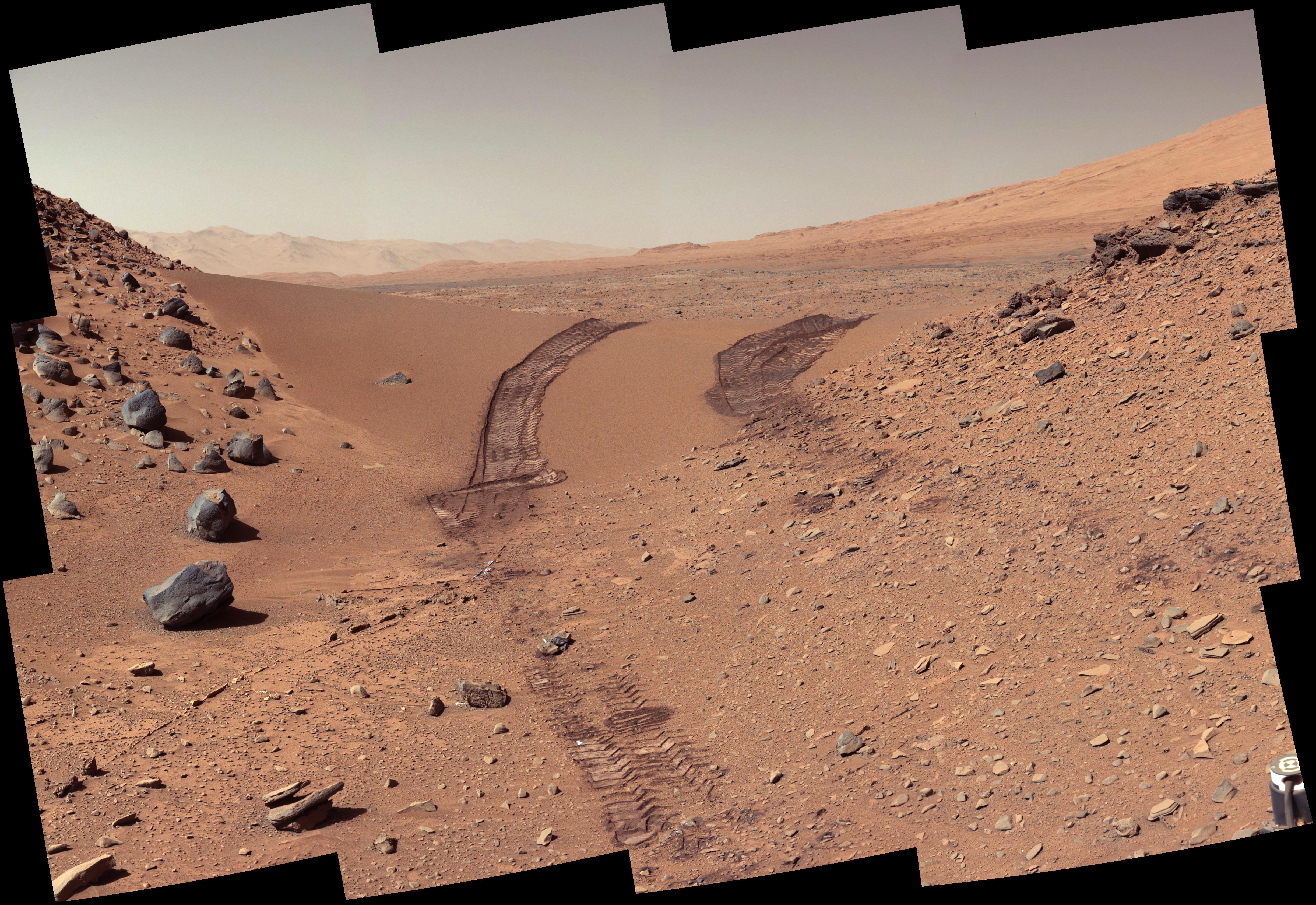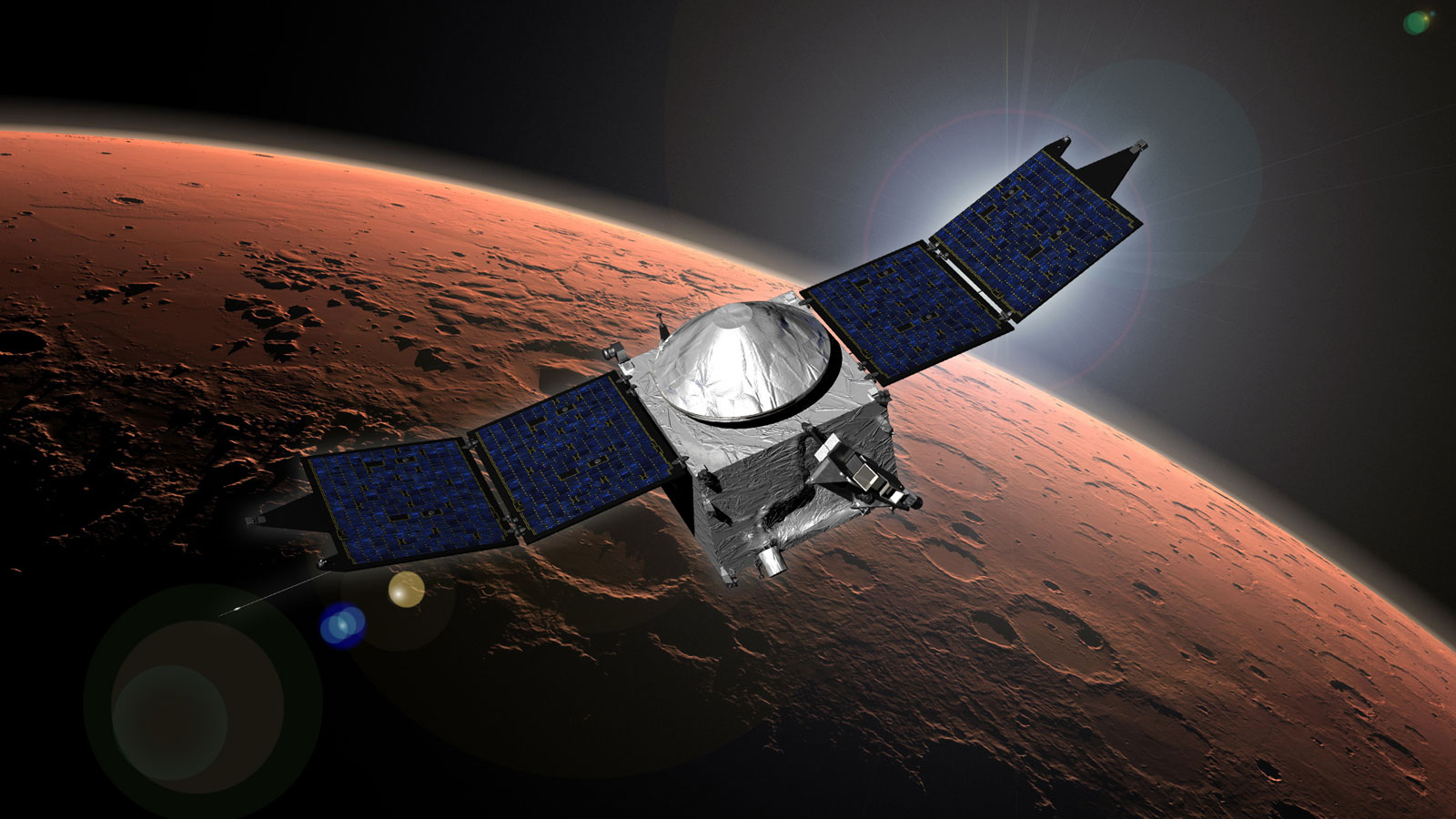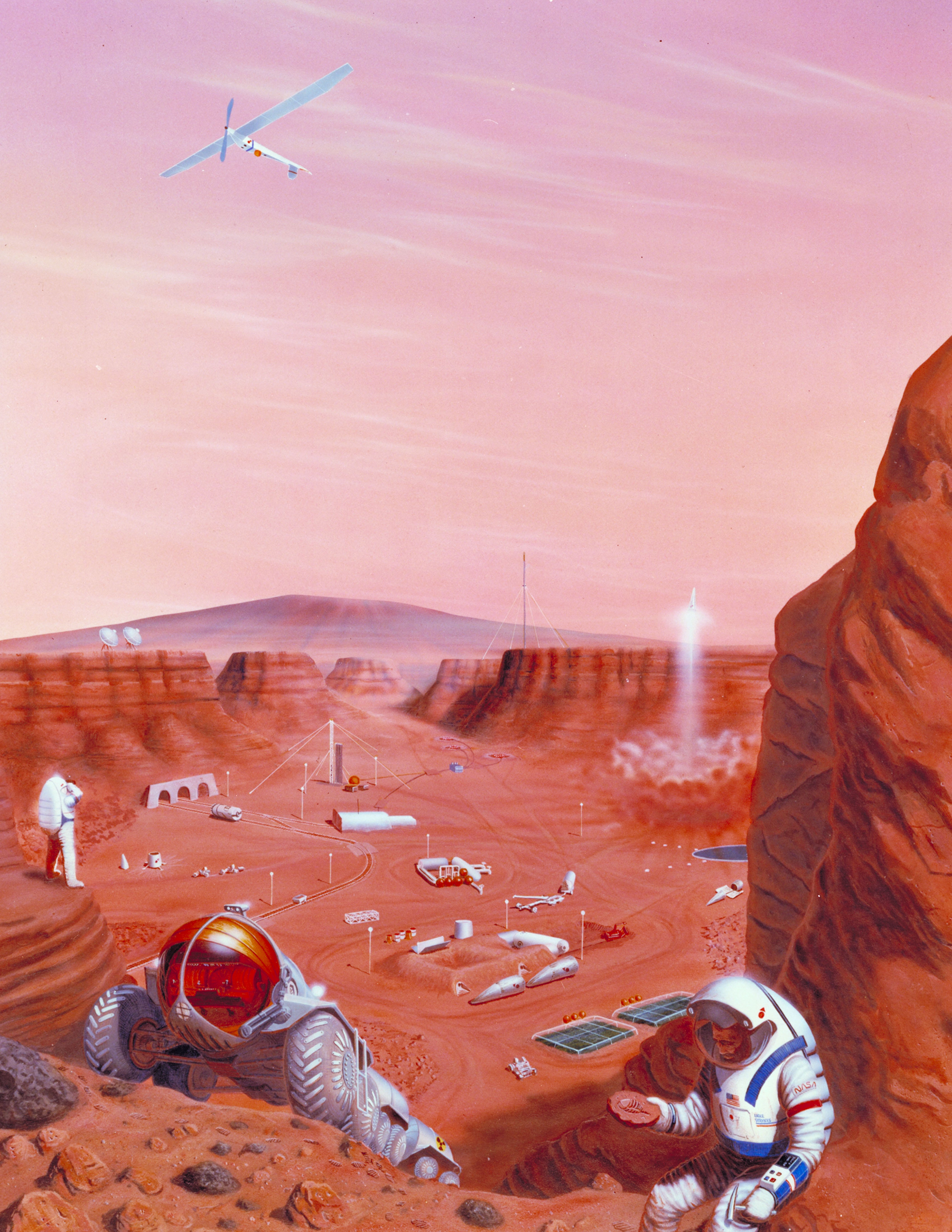Colonization of Mars: Is it Possible?
By John Lendvoy, John Millthorpe, Karan Rajewal and Chase Samuel
Introduction to Mars
Humankind’s curiosity for the unknown and sense of adventure has lead us places we never thought we could reach and made us overcome hostile situations due to our resilient nature. One such destination that we have dreamed of exploring is Mars, the fourth planet from the sun. There are many reasons for wanting to explore the surface of Mars. One of the prominent motivations to explore Mars is to examine the possibility of colonization. By colonizing Mars, we could allow for further growth of the human race without being affected by Earth’s limited resources for a growing population. We know that in the past, Mars was not a barren, dry planet, but was actually very similar to Earth.1 Today, we hold onto hope that Mars is still similar enough to be inhabited by humans some day, but there are some obstacles that we need to overcome if we are to make colonization a reality. By discussing certain characteristics of Mars, including its soil composition, presence of water, composition of its atmosphere as well as the logistics of the trip and the stay, we hope to show how a trip to Mars and its colonization can be feasible in the near future.
Soil Composition

Figure 1: Tracks in the Martian soil left by the Curiosity rover.
Credit: NASA/JPL-Caltech/MSSS
The composition of Martian soil has been studied in considerable detail by the rovers which have been sent up to Mars, such as Pathfinder. We have learned from Pathfinder that the soil on Mars contains nearly all of the minerals essential to supporting plant life, with a notable exception being reactive nitrogen, such as NO3 and NH4.6 This is largely due to the fact that these compounds on Earth have organic origins, and there has yet to be organic matter detected on Mars. That being said, it is speculated that this issue could be resolved through the use of nitrogen fixing bacteria. The purpose of the bacteria is essentially to recreate the nitrogen fixation phase of the nitrogen cycle which occurs on Earth. These bacteria process, or “fix” harmful nitrogen-based compounds from the atmosphere into forms of nitrogen that can be used by plants, such as the compounds mentioned above. This method has been tested using simulated Martian soil, and it was found that growing plants in such a medium with the use of nitrogen fixing bacteria is entirely possible.7
Availability of Water

Figure 2: The northern polar ice cap on Mars.
Credit: NASA/JPL/MSSS
A critical component of both growing plants and human survival on Mars is the availability of water. In September of 2015, NASA published an article on their website saying they found the strongest evidence yet of seasonal flow of liquid water on Mars using an imaging spectrometer aboard the Mars Reconnaissance Orbiter, which you can read more about here. If that is truly what was observed, one could speculate that this water could somehow be collected by astronauts on Mars. Once collected, the water could be used for human consumption or for sustaining crops. That being said, the water that is thought to have been found is believed to be incredibly salty.9 Water of such salinity would need to be treated in some fashion before it could be at all useable by humans.
Much like Earth, Mars has ice caps at its north and south poles. While the north Martian pole (pictured above) is covered with a layer of CO2 ice (or dry ice), the cap is comprised nearly completely of water ice just below the surface.10 One could speculate that this ice could also be collected, and then converted from solid ice to liquid water. One other form of water which has been observed on Mars is in soil samples. The Phoenix lander collected and examined samples of soil in 2008. When heated up above freezing temperature, it was able to use spectroscopy to detect traces of water vapour.11 The Curiosity rover made similar observations, and was able to estimate the water density of the Martian soil to be up to nearly one litre of water per cubic foot of soil. Extraction of this type of water has been tested using simulated lunar soil by microwaving the soil, causing the frozen water to vapourize, and then letting it condense into liquid water.12 It is speculated that this method would work with Martian soil as well.
Atmospheric Composition

Figure 3: The MAVEN orbiter as it orbits Mars.
Credit: NASA/Goddard Space Flight Center
In an attempt to colonize a planet, it is crucial to carefully observe and understand the components of its atmosphere. Although we are lucky to be living in an environment that suits our needs of survival, there are planets in the solar system with environments far more hostile, where life would be impossible for us. Mars has an atmosphere that is unique and different from that of Earth. Earth’s atmosphere is mainly composed of nitrogen and oxygen with minor traces of water vapor, CO2, and other gaseous molecules. Mars’ atmosphere, on the other hand, is primarily composed of CO2 with traces of argon, nitrogen , oxygen and water. Due to its thin atmosphere and greater distance from the Sun than Earth, Mars experiences a temperature far colder, averaging -46°C.13 Mars also experiences considerable variations in temperature during different seasons, due to its tilted axis.

Figure 4: Atmospheric composition of Mars compared to Earth.
Credit: Alex Parent.
Despite the harshness of Mars’ current atmosphere, evidence has suggested that Mars was not always so different from the Earth’s. NASA’s Mars Atmosphere and Volatile Evolution (MAVEN) spacecraft has been sent to sample and determine what has happened to the atmosphere of Mars.14 As it turns out, Mars is losing its atmosphere at a rate of 100 grams per second in the form of oxygen and carbon dioxide ions spewing into the space2. As observed by the MAVEN’s instruments, the planet loses a significant amount of its atmosphere each time it is struck by an interplanetary coronal mass ejection (ICME), which is a burst of gas and magnetism emitted by the sun. The data shows that as the ICME strikes, magnetic rotations flux into the space while at the same time causing discharge of O2 and CO2 ions out from Mars’ atmosphere. The data indicate that Mars has lost a significant amount of its atmosphere due to periods of intense solar bursts from the Sun in its early past. Due to its strong magnetic field, Earth is protected from these severe solar currents; however, if its magnetic field were to disappear, Earth would eventually suffer the same atmospheric loss as Mars.
The Journey to Mars
Now that we know more about the habitability of our destination, another barrier to colonizing Mars is actually getting humans there. It takes somewhere between 150 and 300 days for a shuttle to travel from Earth to Mars. This amount of time depends on the current position of the Earth with respect to Mars, as well as how much fuel the shuttle must consume.2
With such a long travel time, it becomes important to consider what effect the journey will have on the crew. The International Space Station (ISS) is equipped with sensors that measure the levels of radiation inside and outside the vessel; however, since this space station is located within the Earth’s magnetosphere, the radiation levels are well below the threshold that is dangerous for humans. Once we leave the protection of the magnetosphere, the levels increase dramatically.3

Figure 5: Comparison of radiation exposure levels.
Credit: NASA/JPL-Caltech/SwRI
The vessel that will be used to transport astronauts to Mars must be constructed in a way that blocks the radiation that will be present throughout the journey. NASA is currently developing a material comprised of Hydrogenated Boron Nitride Nanotubes, which is capable of blocking the radioactive particles that are harmful to humans. It could be used protect astronauts during the trip to Mars, as well as potentially protect settlers once they have reached the surface.3
It is important to note that women have a lower tolerance than men to extended exposure to the radiation that is present in outer space. The maximum allowed exposure for women is roughly two-thirds that of men, and for that reason, in terms of tolerating exposure to radiation, it could be argued that it is more favourable to have an all-male crew for a trip of such a long duration.4
However, as you can see from Figure 5, the amount of exposure on Mars as well as during the trip is dangerously high for either gender. The problem of radiation would have to be dealt with before sending anyone on this journey. After the issue of radiation is solved, there are actually advantages to sending an all-female crew. For one thing, women typically expend 50% fewer calories than men.15 This means much less food must be sent to sustain the crew during their journey, or perhaps the mission could be twice as long with the same cost for food. Women are also typically physically smaller and lighter than men, and therefore better suited to living in small living quarters. There is also a possibility of sending a mixed-gender crew, which would allow for procreation in a potential Martian colony, Colonization is discussed in more detail in the next section.
Colonization
Once the top minds in this field have developed a way to safely transport astronauts to Mars, the next step will be to find a way to ensure they are able to survive there. For a short-term trip, the essentials for life such as food and water would be sent up to Mars with the astronauts. But if the plan is to colonize the planet, it will be necessary to determine the availability of water and how it can be harnessed. In addition to that, the astronauts will need to be able to grow their own food on Mars for there to be any chance of living there sustainably. As we saw above, it is plausible that someday we may be able to use the soil and water on Mars in our own horticultural endeavours.
Since Mars’ magnetosphere is not capable blocking out the amount of radiation that we are used to here on Earth. In order for humans to survive on the surface, a shelter must be constructed, and inhabitants must spend the majority of their time under the protection of this shelter in order to ensure their maximum radiation levels are not reached.5

Figure 7: An artist’s depiction of humans colonizing Mars.
Credit: NASA.
If our long-term goal is to colonize Mars, another obstacle we need to consider is how we will populate the planet. The National Council on Radiation Protection and Measurements suggests that the maximum amount of radiation that a pregnant woman could be exposed to is 50 mrem/month, but, when living in space, the exposure levels are much higher.4 The solution to this problem is to make use of the radiation-proof shelters to minimize this exposure and to ensure that the new settlers are born without complications.
What does the future hold for Mars?
In its present state, Mars is an inhospitable place for any human. If humans were to colonize Mars, we would have to be protected from its environment. Its air is thin and mostly comprises of carbon dioxide, which means that the people would have to be supplied oxygen through space suits. Also, humans would have to introduce new machinery that must decompose the carbon dioxide in the air as well introduce fresh oxygen to make the air breathable. In a way, we must rebuild the Martian atmosphere in order for humans to be able to survive on Mars.
As a species we have always found a way to overcome obstacles and limitations through our advances in technology, with scientific triumphs occurring at exponentially faster and more impressive rates. This trend and humankind’s need for exploration and expansion are two driving factors that will fuel our mission to Mars. Despite its vast distance and the number of scientific obstacles we face, the prospect of reaching and colonizing Mars exists and can be met if each obstacle is sought after by the brilliant minds and resiliency of humans.
References
1R.Seemangal and A. Thompson, Breaking: NASA confirms how Mars transformed from Earth –like to a Cold Dry Planet, WWW Document, (http://observer.com/2015/11/breaking-nasa-confirms-how-mars-transformed-from-earth-like-to-a-cold-dry-planet/).
2F. Cain, How Long Does It Take To Get To Mars?, WWW Document, (http://www.universetoday.com/14841/how-long-does-it-take-to-get-to-mars/).
3S. Fraszier, Real Martians: How to Protect Astronauts from Space Radiation on Mars, WWW Document, (http://www.nasa.gov/feature/goddard/real-martians-how-to-protect-astronauts-from-space-radiation-on-mars/).
4E. Seedhouse, Survival and Sacrifice in Mars Exploration: What We Know from Polar Expeditions, (Springer Praxis Books, 2015), pp. 47-54.
http://link.springer.com.cyber.usask.ca/book/10.1007%2F978-3-319-12448-3
5Mars-one.com, How much radiation will the settlers be exposed to?, WWW Document,
(http://www.mars-one.com/faq/health-and-ethics/how-much-radiation-will-the-settlers-be-exposed-to).
6Stevens CJ, Manning P, van den Berg LJL, de Graaf MCC, Wamelink GWW, et al. (2011) Ecosystem responses to reduced and oxidised nitrogen inputs in European terrestrial habitats. Environmental Pollution159: 665–676
http://www-ncbi-nlm-nih-gov.cyber.usask.ca/pmc/articles/PMC4146463/#pone.0103138-Stevens1
7Kral TA, Bekkum CR, McKay CP (2004), Growth of methanogens on a mars soil simulant. Origins of Life and Evolution of the Biosphere 34: 615–626
8D. Brown, NASA Confirms Evidence That Liquid Water Flows on Today’s Mars, WWW Document, (http://www.nasa.gov/press-release/nasa-confirms-evidence-that-liquid-water-flows-on-today-s-mars/).
9L. Ojha et al (2015), Spectral evidence for hydrated salts in recurring slope lineae on Mars.
http://www.nature.com/ngeo/journal/v8/n11/full/ngeo2546.html
10D. Darling, Polar Caps of Mars, WWW Document, (http://www.daviddarling.info/encyclopedia/M/Marspoles.html).
11T. Lewis, Incredible Technology: How To Mine Water on Mars, WWW Document, (http://www.space.com/24052-incredible-tech-mining-mars-water.html).
12M. Wall, Curiosity Rover Makes Big Water Discovery in Mars Dirt, a ‘Wow Moment’, WWW Document, (http://www.space.com/22949-mars-water-discovery-curiosity-rover.html).
13M. Williams, Mars Compared To Earth, WWW Document, (http://www.universetoday.com/22603/mars-compared-to-earth/).
14A. Duffy, How the Sun stole Mars’ atmosphere, WWW Document (https://cosmosmagazine.com/space/how-sun-stole-mars-atmosphere).
15K. Greene, An All-Female Mission to Mars, WWW Document (http://www.slate.com/articles/health_and_science/space_20/2014/10/manned_mission_to_mars_female_astronauts_are_cheaper_to_launch_into_outer.html?wpsrc=rollingstone)
